Nursing Ethics: Managing Chronic Migraine with Opiates and Opioids
VerifiedAdded on 2023/06/04
|7
|1754
|470
Essay
AI Summary
This essay explores the ethical issues surrounding the use of opiates and opioid medications in the treatment of chronic migraine pain. It addresses the controversies and dilemmas faced by healthcare practitioners, particularly nurses, in balancing pain relief with the risks of addiction, abuse, and other adverse effects. The paper reflects on the shifting perspectives on opioid legitimization and the uncertainties in their appropriate role in chronic migraine management. It considers the perspectives of both proponents and opponents of opioid use, highlighting the importance of individualized patient care and the need to distinguish between physical dependence and addiction. The essay concludes that while the use of opiates and opioid medications remains controversial, healthcare practitioners must carefully weigh the benefits and risks in each patient's case, recognizing that a generalized viewpoint may not be appropriate.
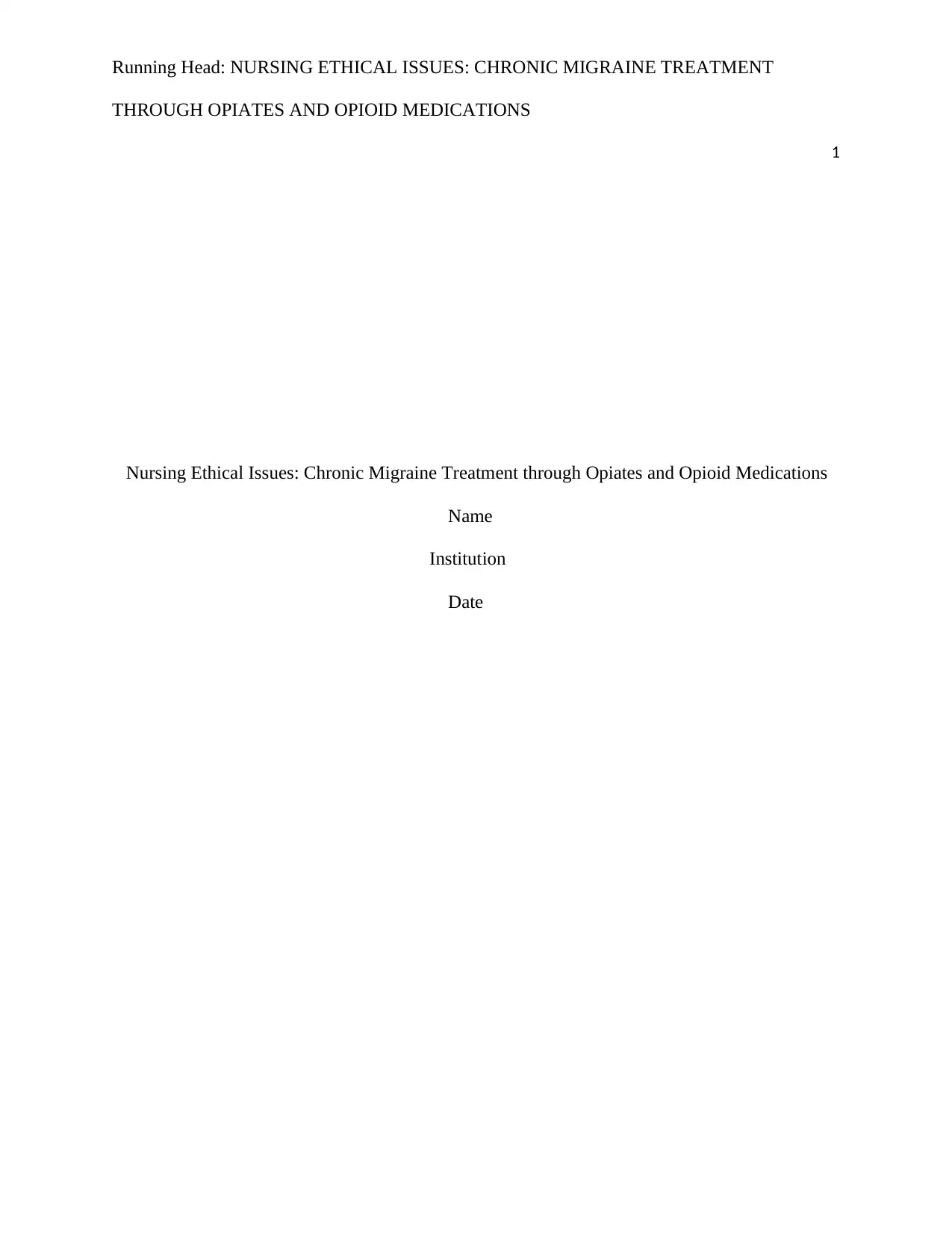
Running Head: NURSING ETHICAL ISSUES: CHRONIC MIGRAINE TREATMENT
THROUGH OPIATES AND OPIOID MEDICATIONS
1
Nursing Ethical Issues: Chronic Migraine Treatment through Opiates and Opioid Medications
Name
Institution
Date
THROUGH OPIATES AND OPIOID MEDICATIONS
1
Nursing Ethical Issues: Chronic Migraine Treatment through Opiates and Opioid Medications
Name
Institution
Date
Paraphrase This Document
Need a fresh take? Get an instant paraphrase of this document with our AI Paraphraser
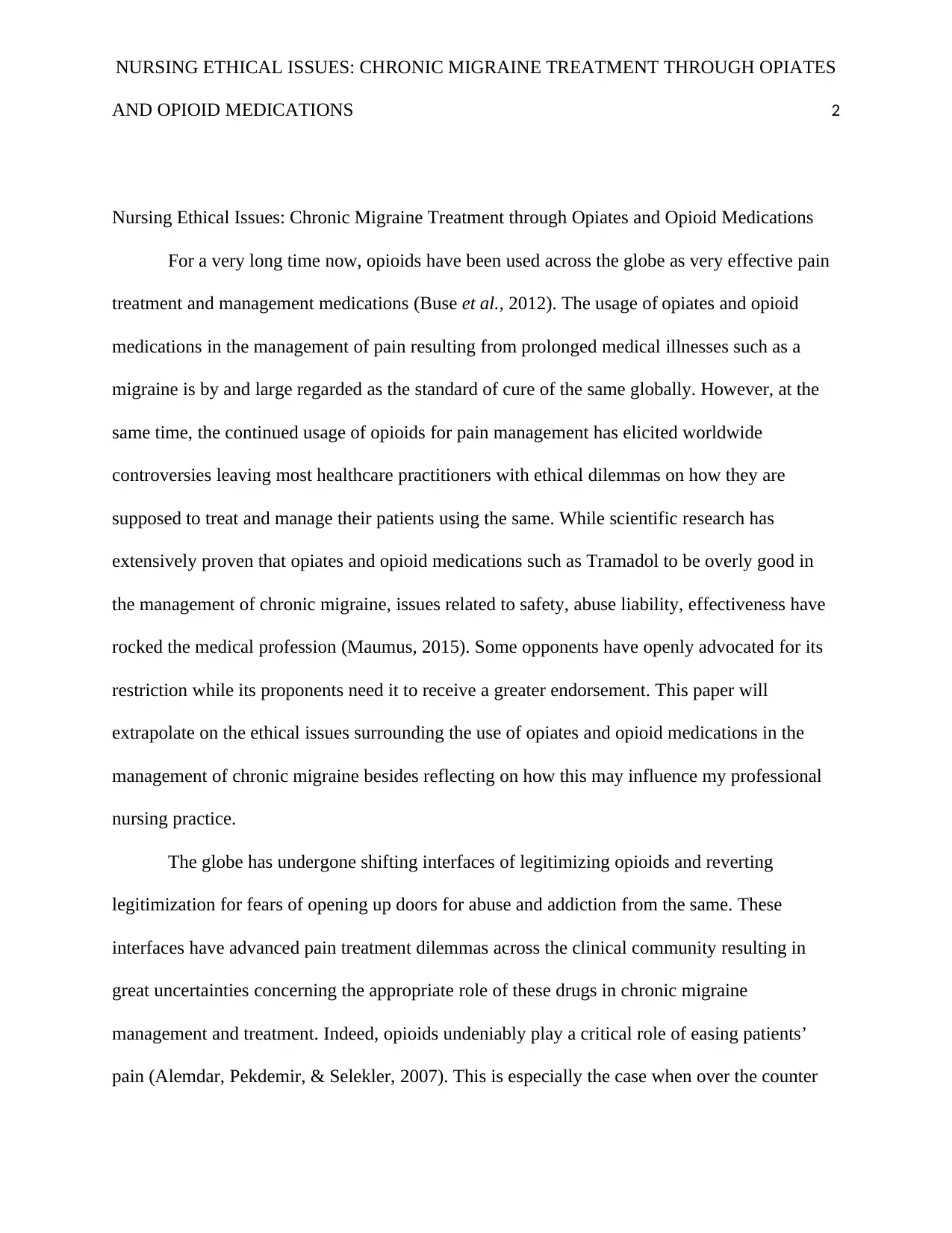
NURSING ETHICAL ISSUES: CHRONIC MIGRAINE TREATMENT THROUGH OPIATES
AND OPIOID MEDICATIONS 2
Nursing Ethical Issues: Chronic Migraine Treatment through Opiates and Opioid Medications
For a very long time now, opioids have been used across the globe as very effective pain
treatment and management medications (Buse et al., 2012). The usage of opiates and opioid
medications in the management of pain resulting from prolonged medical illnesses such as a
migraine is by and large regarded as the standard of cure of the same globally. However, at the
same time, the continued usage of opioids for pain management has elicited worldwide
controversies leaving most healthcare practitioners with ethical dilemmas on how they are
supposed to treat and manage their patients using the same. While scientific research has
extensively proven that opiates and opioid medications such as Tramadol to be overly good in
the management of chronic migraine, issues related to safety, abuse liability, effectiveness have
rocked the medical profession (Maumus, 2015). Some opponents have openly advocated for its
restriction while its proponents need it to receive a greater endorsement. This paper will
extrapolate on the ethical issues surrounding the use of opiates and opioid medications in the
management of chronic migraine besides reflecting on how this may influence my professional
nursing practice.
The globe has undergone shifting interfaces of legitimizing opioids and reverting
legitimization for fears of opening up doors for abuse and addiction from the same. These
interfaces have advanced pain treatment dilemmas across the clinical community resulting in
great uncertainties concerning the appropriate role of these drugs in chronic migraine
management and treatment. Indeed, opioids undeniably play a critical role of easing patients’
pain (Alemdar, Pekdemir, & Selekler, 2007). This is especially the case when over the counter
AND OPIOID MEDICATIONS 2
Nursing Ethical Issues: Chronic Migraine Treatment through Opiates and Opioid Medications
For a very long time now, opioids have been used across the globe as very effective pain
treatment and management medications (Buse et al., 2012). The usage of opiates and opioid
medications in the management of pain resulting from prolonged medical illnesses such as a
migraine is by and large regarded as the standard of cure of the same globally. However, at the
same time, the continued usage of opioids for pain management has elicited worldwide
controversies leaving most healthcare practitioners with ethical dilemmas on how they are
supposed to treat and manage their patients using the same. While scientific research has
extensively proven that opiates and opioid medications such as Tramadol to be overly good in
the management of chronic migraine, issues related to safety, abuse liability, effectiveness have
rocked the medical profession (Maumus, 2015). Some opponents have openly advocated for its
restriction while its proponents need it to receive a greater endorsement. This paper will
extrapolate on the ethical issues surrounding the use of opiates and opioid medications in the
management of chronic migraine besides reflecting on how this may influence my professional
nursing practice.
The globe has undergone shifting interfaces of legitimizing opioids and reverting
legitimization for fears of opening up doors for abuse and addiction from the same. These
interfaces have advanced pain treatment dilemmas across the clinical community resulting in
great uncertainties concerning the appropriate role of these drugs in chronic migraine
management and treatment. Indeed, opioids undeniably play a critical role of easing patients’
pain (Alemdar, Pekdemir, & Selekler, 2007). This is especially the case when over the counter
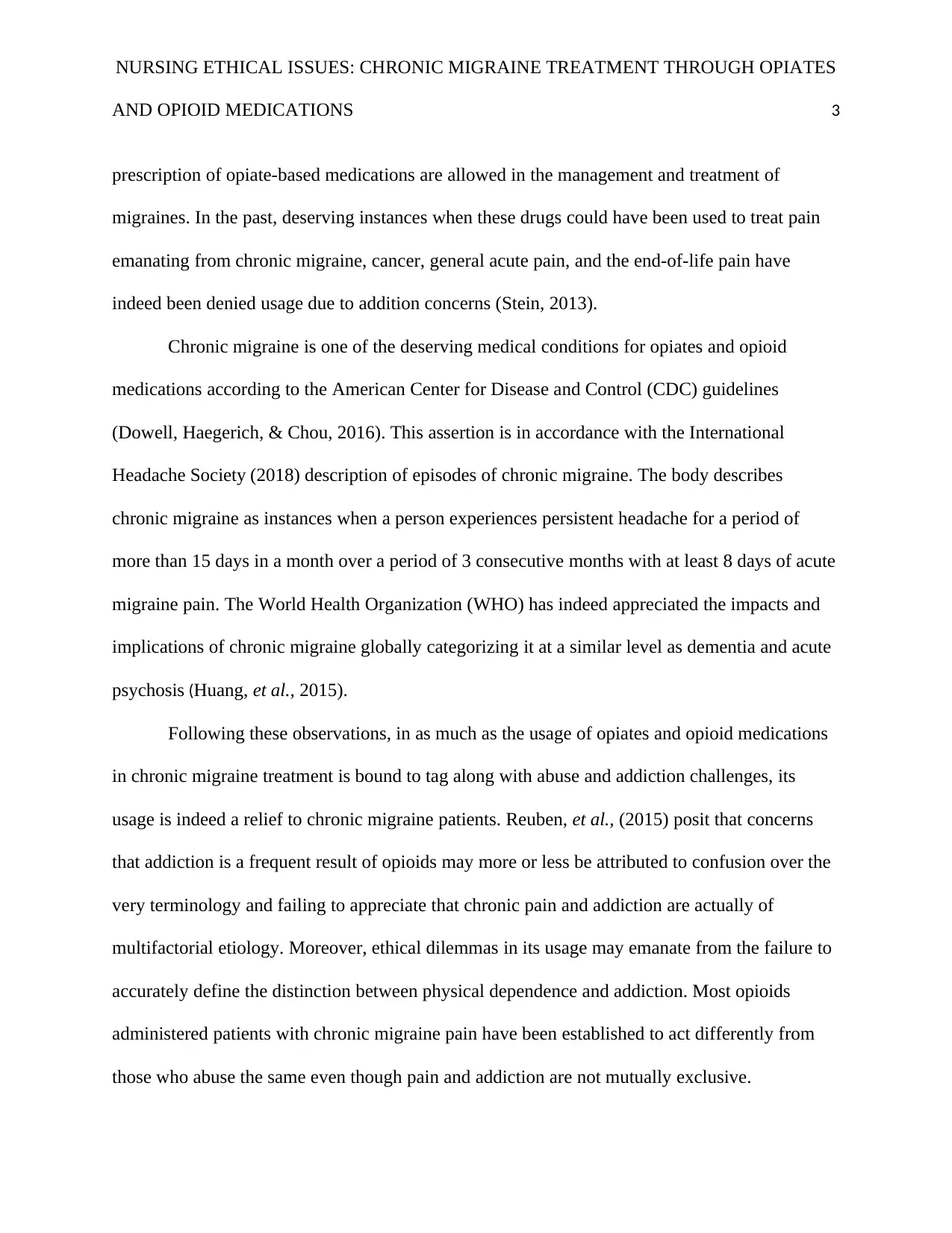
NURSING ETHICAL ISSUES: CHRONIC MIGRAINE TREATMENT THROUGH OPIATES
AND OPIOID MEDICATIONS 3
prescription of opiate-based medications are allowed in the management and treatment of
migraines. In the past, deserving instances when these drugs could have been used to treat pain
emanating from chronic migraine, cancer, general acute pain, and the end-of-life pain have
indeed been denied usage due to addition concerns (Stein, 2013).
Chronic migraine is one of the deserving medical conditions for opiates and opioid
medications according to the American Center for Disease and Control (CDC) guidelines
(Dowell, Haegerich, & Chou, 2016). This assertion is in accordance with the International
Headache Society (2018) description of episodes of chronic migraine. The body describes
chronic migraine as instances when a person experiences persistent headache for a period of
more than 15 days in a month over a period of 3 consecutive months with at least 8 days of acute
migraine pain. The World Health Organization (WHO) has indeed appreciated the impacts and
implications of chronic migraine globally categorizing it at a similar level as dementia and acute
psychosis (Huang, et al., 2015).
Following these observations, in as much as the usage of opiates and opioid medications
in chronic migraine treatment is bound to tag along with abuse and addiction challenges, its
usage is indeed a relief to chronic migraine patients. Reuben, et al., (2015) posit that concerns
that addiction is a frequent result of opioids may more or less be attributed to confusion over the
very terminology and failing to appreciate that chronic pain and addiction are actually of
multifactorial etiology. Moreover, ethical dilemmas in its usage may emanate from the failure to
accurately define the distinction between physical dependence and addiction. Most opioids
administered patients with chronic migraine pain have been established to act differently from
those who abuse the same even though pain and addiction are not mutually exclusive.
AND OPIOID MEDICATIONS 3
prescription of opiate-based medications are allowed in the management and treatment of
migraines. In the past, deserving instances when these drugs could have been used to treat pain
emanating from chronic migraine, cancer, general acute pain, and the end-of-life pain have
indeed been denied usage due to addition concerns (Stein, 2013).
Chronic migraine is one of the deserving medical conditions for opiates and opioid
medications according to the American Center for Disease and Control (CDC) guidelines
(Dowell, Haegerich, & Chou, 2016). This assertion is in accordance with the International
Headache Society (2018) description of episodes of chronic migraine. The body describes
chronic migraine as instances when a person experiences persistent headache for a period of
more than 15 days in a month over a period of 3 consecutive months with at least 8 days of acute
migraine pain. The World Health Organization (WHO) has indeed appreciated the impacts and
implications of chronic migraine globally categorizing it at a similar level as dementia and acute
psychosis (Huang, et al., 2015).
Following these observations, in as much as the usage of opiates and opioid medications
in chronic migraine treatment is bound to tag along with abuse and addiction challenges, its
usage is indeed a relief to chronic migraine patients. Reuben, et al., (2015) posit that concerns
that addiction is a frequent result of opioids may more or less be attributed to confusion over the
very terminology and failing to appreciate that chronic pain and addiction are actually of
multifactorial etiology. Moreover, ethical dilemmas in its usage may emanate from the failure to
accurately define the distinction between physical dependence and addiction. Most opioids
administered patients with chronic migraine pain have been established to act differently from
those who abuse the same even though pain and addiction are not mutually exclusive.
⊘ This is a preview!⊘
Do you want full access?
Subscribe today to unlock all pages.

Trusted by 1+ million students worldwide
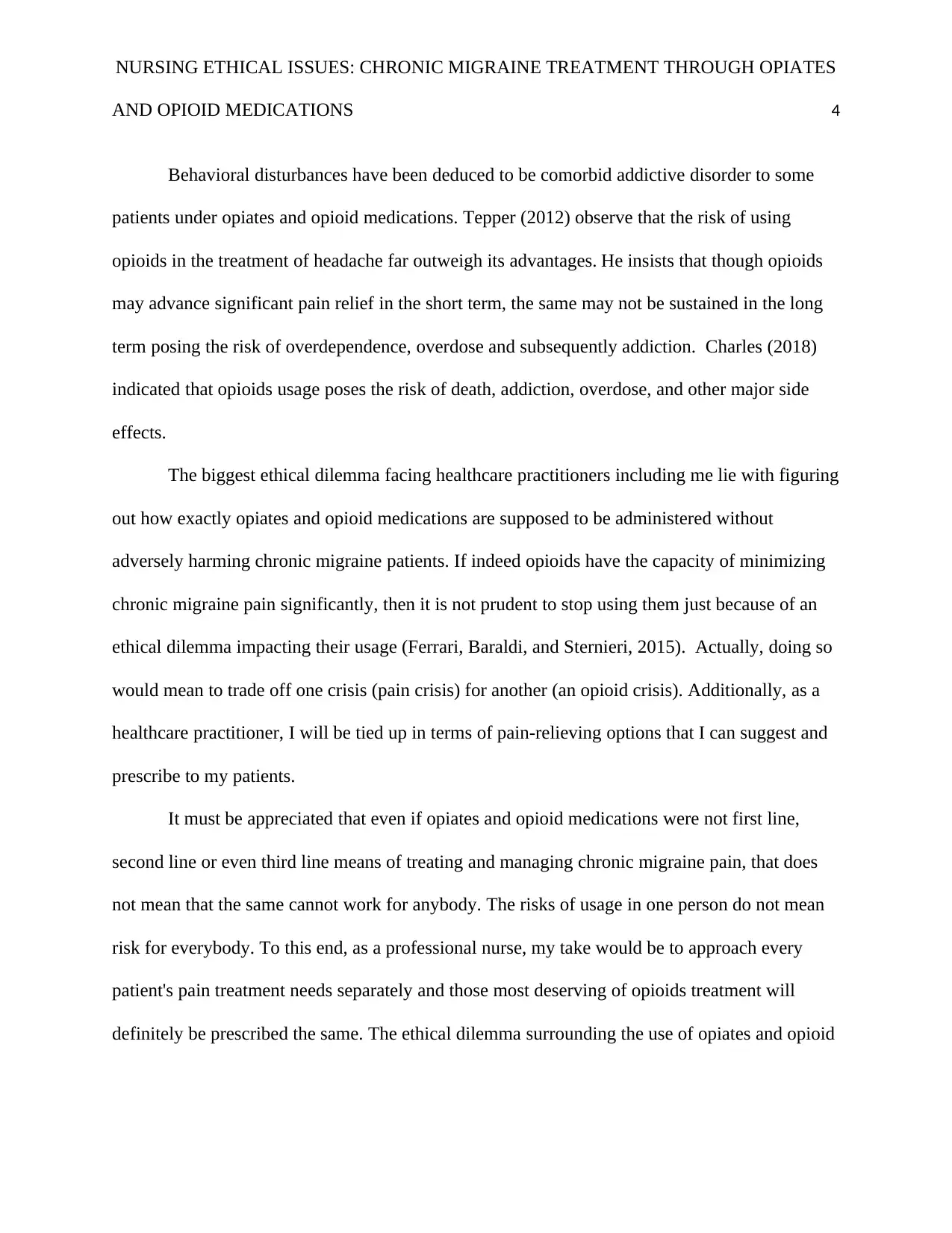
NURSING ETHICAL ISSUES: CHRONIC MIGRAINE TREATMENT THROUGH OPIATES
AND OPIOID MEDICATIONS 4
Behavioral disturbances have been deduced to be comorbid addictive disorder to some
patients under opiates and opioid medications. Tepper (2012) observe that the risk of using
opioids in the treatment of headache far outweigh its advantages. He insists that though opioids
may advance significant pain relief in the short term, the same may not be sustained in the long
term posing the risk of overdependence, overdose and subsequently addiction. Charles (2018)
indicated that opioids usage poses the risk of death, addiction, overdose, and other major side
effects.
The biggest ethical dilemma facing healthcare practitioners including me lie with figuring
out how exactly opiates and opioid medications are supposed to be administered without
adversely harming chronic migraine patients. If indeed opioids have the capacity of minimizing
chronic migraine pain significantly, then it is not prudent to stop using them just because of an
ethical dilemma impacting their usage (Ferrari, Baraldi, and Sternieri, 2015). Actually, doing so
would mean to trade off one crisis (pain crisis) for another (an opioid crisis). Additionally, as a
healthcare practitioner, I will be tied up in terms of pain-relieving options that I can suggest and
prescribe to my patients.
It must be appreciated that even if opiates and opioid medications were not first line,
second line or even third line means of treating and managing chronic migraine pain, that does
not mean that the same cannot work for anybody. The risks of usage in one person do not mean
risk for everybody. To this end, as a professional nurse, my take would be to approach every
patient's pain treatment needs separately and those most deserving of opioids treatment will
definitely be prescribed the same. The ethical dilemma surrounding the use of opiates and opioid
AND OPIOID MEDICATIONS 4
Behavioral disturbances have been deduced to be comorbid addictive disorder to some
patients under opiates and opioid medications. Tepper (2012) observe that the risk of using
opioids in the treatment of headache far outweigh its advantages. He insists that though opioids
may advance significant pain relief in the short term, the same may not be sustained in the long
term posing the risk of overdependence, overdose and subsequently addiction. Charles (2018)
indicated that opioids usage poses the risk of death, addiction, overdose, and other major side
effects.
The biggest ethical dilemma facing healthcare practitioners including me lie with figuring
out how exactly opiates and opioid medications are supposed to be administered without
adversely harming chronic migraine patients. If indeed opioids have the capacity of minimizing
chronic migraine pain significantly, then it is not prudent to stop using them just because of an
ethical dilemma impacting their usage (Ferrari, Baraldi, and Sternieri, 2015). Actually, doing so
would mean to trade off one crisis (pain crisis) for another (an opioid crisis). Additionally, as a
healthcare practitioner, I will be tied up in terms of pain-relieving options that I can suggest and
prescribe to my patients.
It must be appreciated that even if opiates and opioid medications were not first line,
second line or even third line means of treating and managing chronic migraine pain, that does
not mean that the same cannot work for anybody. The risks of usage in one person do not mean
risk for everybody. To this end, as a professional nurse, my take would be to approach every
patient's pain treatment needs separately and those most deserving of opioids treatment will
definitely be prescribed the same. The ethical dilemma surrounding the use of opiates and opioid
Paraphrase This Document
Need a fresh take? Get an instant paraphrase of this document with our AI Paraphraser
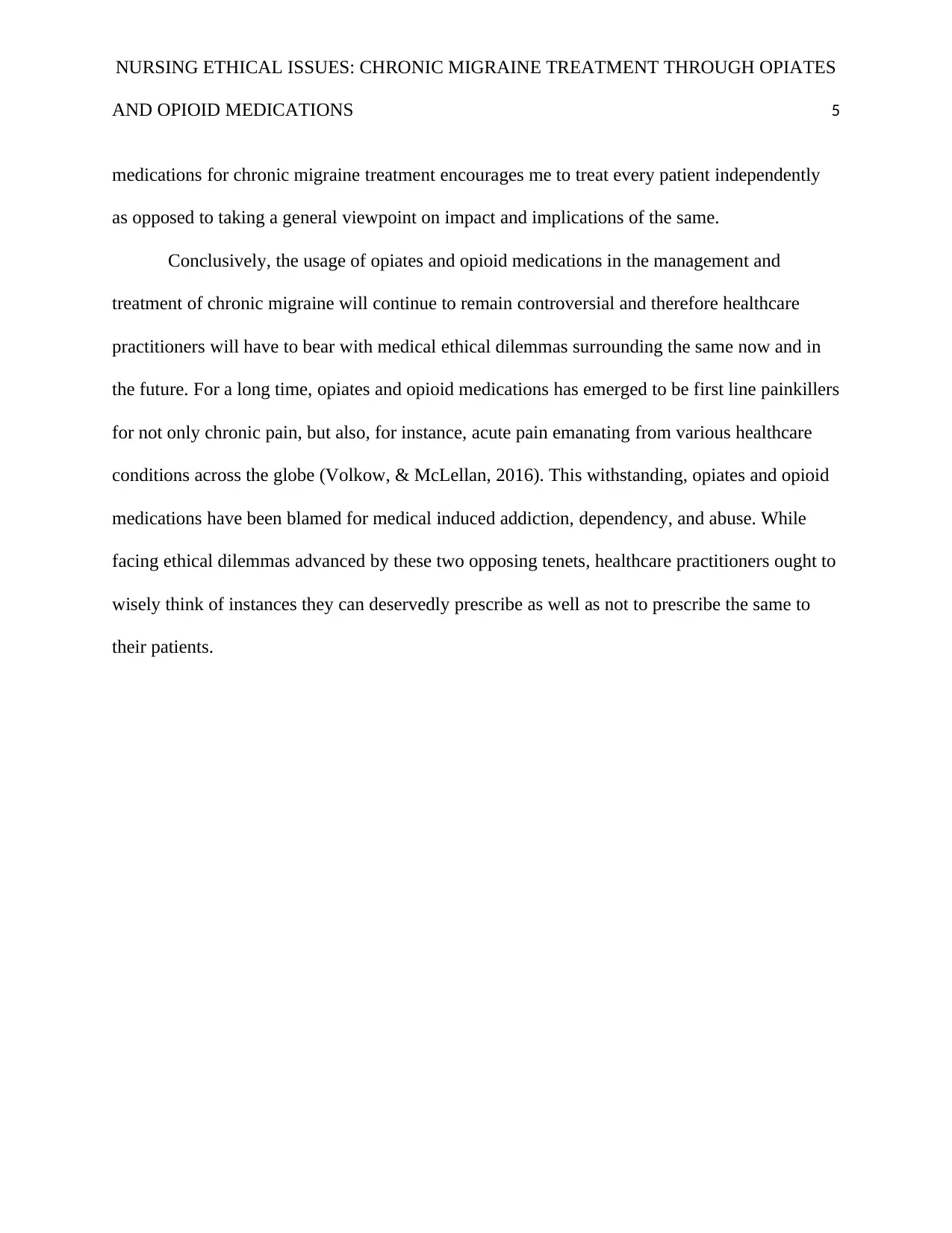
NURSING ETHICAL ISSUES: CHRONIC MIGRAINE TREATMENT THROUGH OPIATES
AND OPIOID MEDICATIONS 5
medications for chronic migraine treatment encourages me to treat every patient independently
as opposed to taking a general viewpoint on impact and implications of the same.
Conclusively, the usage of opiates and opioid medications in the management and
treatment of chronic migraine will continue to remain controversial and therefore healthcare
practitioners will have to bear with medical ethical dilemmas surrounding the same now and in
the future. For a long time, opiates and opioid medications has emerged to be first line painkillers
for not only chronic pain, but also, for instance, acute pain emanating from various healthcare
conditions across the globe (Volkow, & McLellan, 2016). This withstanding, opiates and opioid
medications have been blamed for medical induced addiction, dependency, and abuse. While
facing ethical dilemmas advanced by these two opposing tenets, healthcare practitioners ought to
wisely think of instances they can deservedly prescribe as well as not to prescribe the same to
their patients.
AND OPIOID MEDICATIONS 5
medications for chronic migraine treatment encourages me to treat every patient independently
as opposed to taking a general viewpoint on impact and implications of the same.
Conclusively, the usage of opiates and opioid medications in the management and
treatment of chronic migraine will continue to remain controversial and therefore healthcare
practitioners will have to bear with medical ethical dilemmas surrounding the same now and in
the future. For a long time, opiates and opioid medications has emerged to be first line painkillers
for not only chronic pain, but also, for instance, acute pain emanating from various healthcare
conditions across the globe (Volkow, & McLellan, 2016). This withstanding, opiates and opioid
medications have been blamed for medical induced addiction, dependency, and abuse. While
facing ethical dilemmas advanced by these two opposing tenets, healthcare practitioners ought to
wisely think of instances they can deservedly prescribe as well as not to prescribe the same to
their patients.
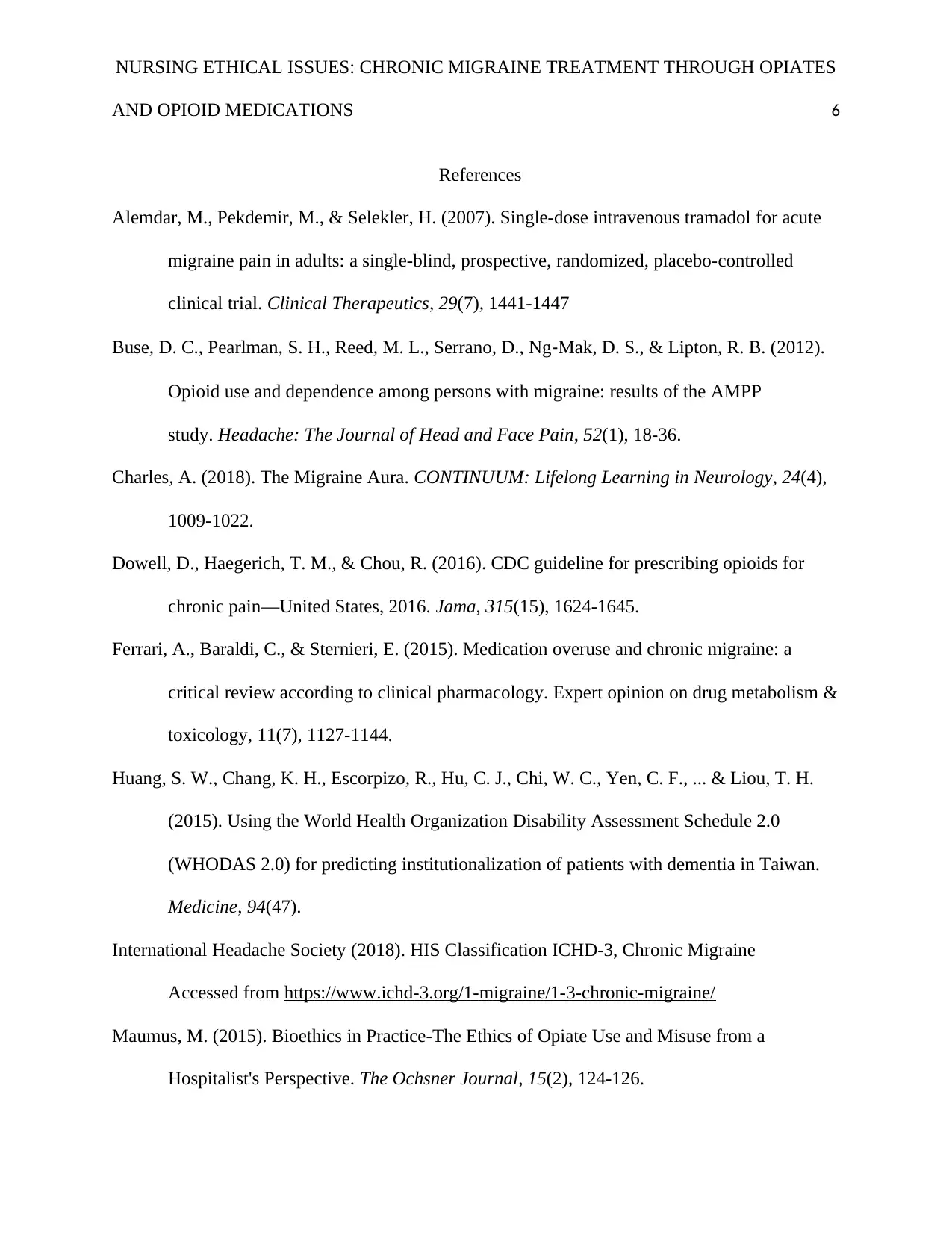
NURSING ETHICAL ISSUES: CHRONIC MIGRAINE TREATMENT THROUGH OPIATES
AND OPIOID MEDICATIONS 6
References
Alemdar, M., Pekdemir, M., & Selekler, H. (2007). Single-dose intravenous tramadol for acute
migraine pain in adults: a single-blind, prospective, randomized, placebo-controlled
clinical trial. Clinical Therapeutics, 29(7), 1441-1447
Buse, D. C., Pearlman, S. H., Reed, M. L., Serrano, D., Ng‐Mak, D. S., & Lipton, R. B. (2012).
Opioid use and dependence among persons with migraine: results of the AMPP
study. Headache: The Journal of Head and Face Pain, 52(1), 18-36.
Charles, A. (2018). The Migraine Aura. CONTINUUM: Lifelong Learning in Neurology, 24(4),
1009-1022.
Dowell, D., Haegerich, T. M., & Chou, R. (2016). CDC guideline for prescribing opioids for
chronic pain—United States, 2016. Jama, 315(15), 1624-1645.
Ferrari, A., Baraldi, C., & Sternieri, E. (2015). Medication overuse and chronic migraine: a
critical review according to clinical pharmacology. Expert opinion on drug metabolism &
toxicology, 11(7), 1127-1144.
Huang, S. W., Chang, K. H., Escorpizo, R., Hu, C. J., Chi, W. C., Yen, C. F., ... & Liou, T. H.
(2015). Using the World Health Organization Disability Assessment Schedule 2.0
(WHODAS 2.0) for predicting institutionalization of patients with dementia in Taiwan.
Medicine, 94(47).
International Headache Society (2018). HIS Classification ICHD-3, Chronic Migraine
Accessed from https://www.ichd-3.org/1-migraine/1-3-chronic-migraine/
Maumus, M. (2015). Bioethics in Practice-The Ethics of Opiate Use and Misuse from a
Hospitalist's Perspective. The Ochsner Journal, 15(2), 124-126.
AND OPIOID MEDICATIONS 6
References
Alemdar, M., Pekdemir, M., & Selekler, H. (2007). Single-dose intravenous tramadol for acute
migraine pain in adults: a single-blind, prospective, randomized, placebo-controlled
clinical trial. Clinical Therapeutics, 29(7), 1441-1447
Buse, D. C., Pearlman, S. H., Reed, M. L., Serrano, D., Ng‐Mak, D. S., & Lipton, R. B. (2012).
Opioid use and dependence among persons with migraine: results of the AMPP
study. Headache: The Journal of Head and Face Pain, 52(1), 18-36.
Charles, A. (2018). The Migraine Aura. CONTINUUM: Lifelong Learning in Neurology, 24(4),
1009-1022.
Dowell, D., Haegerich, T. M., & Chou, R. (2016). CDC guideline for prescribing opioids for
chronic pain—United States, 2016. Jama, 315(15), 1624-1645.
Ferrari, A., Baraldi, C., & Sternieri, E. (2015). Medication overuse and chronic migraine: a
critical review according to clinical pharmacology. Expert opinion on drug metabolism &
toxicology, 11(7), 1127-1144.
Huang, S. W., Chang, K. H., Escorpizo, R., Hu, C. J., Chi, W. C., Yen, C. F., ... & Liou, T. H.
(2015). Using the World Health Organization Disability Assessment Schedule 2.0
(WHODAS 2.0) for predicting institutionalization of patients with dementia in Taiwan.
Medicine, 94(47).
International Headache Society (2018). HIS Classification ICHD-3, Chronic Migraine
Accessed from https://www.ichd-3.org/1-migraine/1-3-chronic-migraine/
Maumus, M. (2015). Bioethics in Practice-The Ethics of Opiate Use and Misuse from a
Hospitalist's Perspective. The Ochsner Journal, 15(2), 124-126.
⊘ This is a preview!⊘
Do you want full access?
Subscribe today to unlock all pages.

Trusted by 1+ million students worldwide
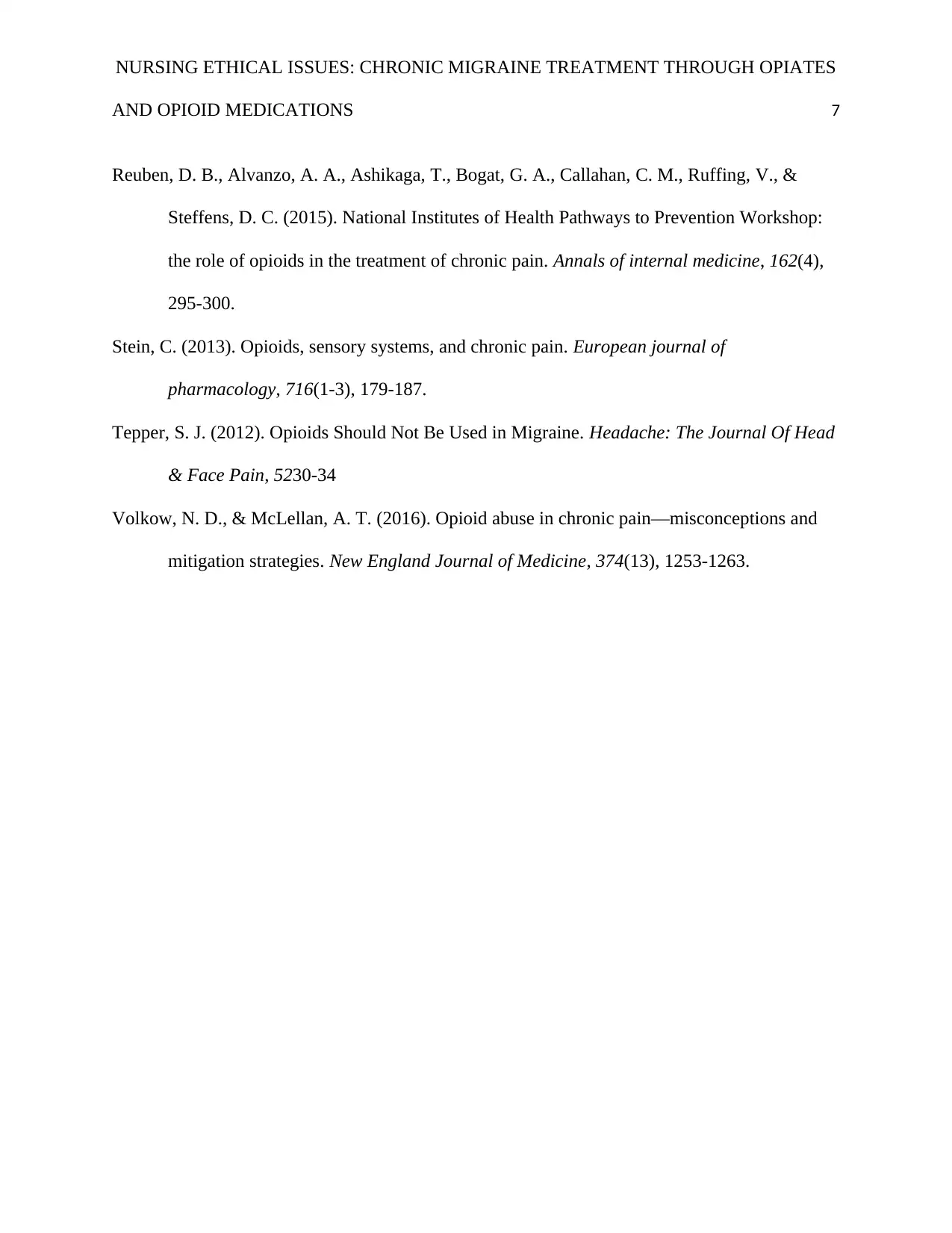
NURSING ETHICAL ISSUES: CHRONIC MIGRAINE TREATMENT THROUGH OPIATES
AND OPIOID MEDICATIONS 7
Reuben, D. B., Alvanzo, A. A., Ashikaga, T., Bogat, G. A., Callahan, C. M., Ruffing, V., &
Steffens, D. C. (2015). National Institutes of Health Pathways to Prevention Workshop:
the role of opioids in the treatment of chronic pain. Annals of internal medicine, 162(4),
295-300.
Stein, C. (2013). Opioids, sensory systems, and chronic pain. European journal of
pharmacology, 716(1-3), 179-187.
Tepper, S. J. (2012). Opioids Should Not Be Used in Migraine. Headache: The Journal Of Head
& Face Pain, 5230-34
Volkow, N. D., & McLellan, A. T. (2016). Opioid abuse in chronic pain—misconceptions and
mitigation strategies. New England Journal of Medicine, 374(13), 1253-1263.
AND OPIOID MEDICATIONS 7
Reuben, D. B., Alvanzo, A. A., Ashikaga, T., Bogat, G. A., Callahan, C. M., Ruffing, V., &
Steffens, D. C. (2015). National Institutes of Health Pathways to Prevention Workshop:
the role of opioids in the treatment of chronic pain. Annals of internal medicine, 162(4),
295-300.
Stein, C. (2013). Opioids, sensory systems, and chronic pain. European journal of
pharmacology, 716(1-3), 179-187.
Tepper, S. J. (2012). Opioids Should Not Be Used in Migraine. Headache: The Journal Of Head
& Face Pain, 5230-34
Volkow, N. D., & McLellan, A. T. (2016). Opioid abuse in chronic pain—misconceptions and
mitigation strategies. New England Journal of Medicine, 374(13), 1253-1263.
1 out of 7
Related Documents
Your All-in-One AI-Powered Toolkit for Academic Success.
+13062052269
info@desklib.com
Available 24*7 on WhatsApp / Email
![[object Object]](/_next/static/media/star-bottom.7253800d.svg)
Unlock your academic potential
Copyright © 2020–2025 A2Z Services. All Rights Reserved. Developed and managed by ZUCOL.





